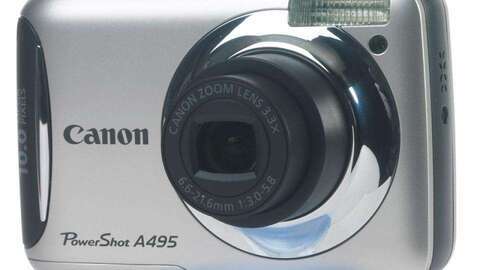Canon PowerShot A495 review
With most cameras at this price using 12-megapixel sensors, Canon deserves praise for bucking the trend with this 10-megapixel camera. That’s more than enough detail for a compact camera, and should result in less noise in low light.
This model was announced in January 2010 and is only just appearing in the shops. However, other than its support for SDXC cards (for capacities over SDHC’s 32GB limit), the design seems dated.
It’s small but quite chunky, thanks in part to the use of AA batteries. These are cumbersome compared to a Li-ion rechargeable battery, and they’re slow to recharge the flash – we measured around six seconds between shots when illuminating subjects at close distance, and over 12 seconds when using the flash at full power.
The 2.5in screen is the smallest we’ve seen for many months. The lens lacks optical stabilisation or the wide-angle shooting that’s increasingly common among compact cameras. Its 1cm macro mode is impressive, capturing details that are smaller than the eye can see.
We’re also pleased to see that there’s an orientation sensor for detecting when photos have been shot in portrait orientation – a rarity at this price. As well as tagging photos for correct orientation on a PC, it’s used to rotate shots during playback on the camera. When a portrait-shaped photo appears, turning the camera on its side makes it fill the screen.
Image quality in most of our tests was excellent, with well-judged automatic exposures and sharp focus into the corners at all zoom positions. Details fell away sharply in low light at high ISO sensitivities but noise wasn’t excessive, and nor were the surreal splodges of noise-reduction artefacts suffered by most 12-megapixel compact cameras.
There’s nothing wrong with the A495, and if the price falls well below £100 we’d have no reservations recommending it. However, by the time you’ve budgeted for AA batteries and a charger, for the same money you could buy Panasonic’s vastly more capable Lumix DMC-FP8.
|
Basic Specifications |
|
Rating |
*** |
|
CCD effective megapixels |
10.0 megapixels |
|
CCD size |
1/2.3in |
|
Viewfinder |
none |
|
Viewfinder magnification, coverage |
N/A |
|
LCD screen size |
2.5in |
|
LCD screen resolution |
115,000 pixels |
|
Articulated screen |
No |
|
Live view |
Yes |
|
Optical zoom |
3.3x |
|
Zoom 35mm equivalent |
37-122mm |
|
Image stabilisation |
none |
|
Maximum image resolution |
3,648x2,736 |
|
Maximum movie resolution |
640x480 |
|
Movie frame rate at max quality |
30fps |
|
File formats |
JPEG; AVI (M-JPEG) |
|
Physical |
|
Memory slot |
SDXC |
|
Mermory supplied |
none |
|
Battery type |
2x AA |
|
Battery Life (tested) |
400 shots |
|
Connectivity |
USB, AV, DC in |
|
HDMI output resolution |
N/A |
|
Body material |
plastic |
|
Lens mount |
N/A |
|
Focal length multiplier |
5.6x |
|
Kit lens model name |
N/A |
|
Accessories |
USB and AV cables |
|
Weight |
175g |
|
Size |
62x94x31mm |
|
Buying Information |
|
Warranty |
one year RTB |
|
Price |
£111 |
|
Supplier |
http://www.lambda-tek.com/componentshop |
|
Details |
www.canon.co.uk |
|
Camera Controls |
|
Exposure modes |
auto |
|
Shutter speed |
15 to 1/2,000 seconds |
|
Aperture range |
f/3 to f/5.8 |
|
ISO range (at full resolution) |
80 to 1600 |
|
Exposure compensation |
+/-2 EV |
|
White balance |
auto, 5 presets, manual |
|
Additional image controls |
contrast, saturation, sharpness |
|
Manual focus |
No |
|
Closest macro focus |
1cm |
|
Auto-focus modes |
multi, face detect |
|
Metering modes |
multi, centre-weighted, centre, face detect |
|
Flash |
auto, forced, suppressed, slow synchro, red-eye reduction |
|
Drive modes |
single, continuous, self-timer |
Basic Specifications
Physical
Buying Information
Camera Controls
